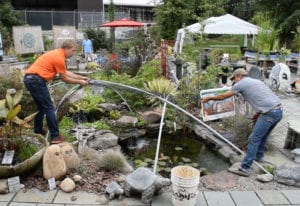
Ever wonder why fish are so smart?
Because they’re always in schools!
With back-to-school season underway, your pond’s fish and plants are enjoying their last hurrah before cooler temperatures. You don’t need to change much yet as far as pond maintenance – but you will want to start thinking ahead for winter.
That preparation includes getting ready to switch up your fish’s diet for the season. Check out Tip No. 2 below to learn more about their nutritional needs this month, or read out September Deep-Dive for information about when (and why) to switch to Cold Water food.
3 Tips for September Pond Care
1. Schedule Fall Pond Service
 Performing some basic maintenance in the early fall can save you a lot of work in the spring.
Performing some basic maintenance in the early fall can save you a lot of work in the spring.
During your Fall Service Visit, our crew will cut back plants, clean filters and install netting to keep those pretty falling leaves out of the water. We’ll take the net down around Thanksgiving once all the leaves are down – letting you enjoy an unobstructed view of your pond all winter.
To keep things convenient, you can schedule your Fall Service visit, net removal and winterization in one simple form.
> Click here to request Fall Service
2. Pack in nutrients
Your fish will probably act like their normal, active, hungry selves this month – but that won’t last too much longer.
Pond fish go into a semi-dormant state called torpor in winter. You shouldn’t feed your fish after water drops below 50-55 degrees, but you can help them pack in some nutrients in these warm late summer and early autumn days.
Add small amounts of Koi Krunchies, watermelon, orange slices or other protein- and vitamin-packed snacks to your fish’s diets, in addition to their regular diet to give them a boost.
> Find Koi Krunchies at our Online Store
As always, only feed your fish as much as they’ll eat in about five minutes. But as long as your fish are eating what you feed them, go ahead and enjoy these last few weeks of bonding with your finned friends.
3. Continue weekly doses of Beneficial Bacteria
 Beneficial Bacteria is our go-to water treatment for keeping water crystal-clear and fish happy and healthy.
Beneficial Bacteria is our go-to water treatment for keeping water crystal-clear and fish happy and healthy.
Bacteria do lots of helpful things for your pond, including consuming harmful ammonia and algae-causing nitrites. For best results, apply bacteria at least once a week throughout the season, or install an Automatic Dosing System that will do the work for you.
Pond Bacteria comes in lots of forms – so how do you know which one you need?
Just follow this guide:
- For water below 50 degrees: Cold Water Bacteria (Available at Splash)
- For water above 50 degrees: Beneficial Bacteria (Available at Splash)
- For new ponds, recently cleaned ponds or springtime ponds above 40 degrees: Pond Starter Bacteria (Available at Splash)
- For Automatic Dosing Systems: Maintain for Ponds Autodoser Pouch (Available at Splash)
In September, you’ll likely be using regular Beneficial Bacteria.
Liquid Beneficial Bacteria comes in an easy-to-use pump-top container. If you buy an 8 oz, 16 oz, or 32 oz bottle, simply add one pump of bacteria per 100 gallons of water in your pond once a week. If you buy a gallon bottle, use one pump per 600 gallons.
(Dry forms of bacteria are also available. See your container for dosing instructions.)
To Calculate Pond Size in US Gallons: Length (in feet) x Width (in feet) x Average Depth (in feet) x 7.48
All of the Beneficial Bacteria products listed above are completely safe for fish and plants – making them a great alternative to potentially harmful algaecides.
September Deep-Dive
When to Switch to Cold Water Food

Fall is a finicky season.Temperatures in early and mid October often sway from summer-like highs in the 80s to chilly lows in the 40s. This all-over-the-place weather can confuse pond owners who want to prep for the changing seasons.
Here are a few tips to help your fish through a Pennsylvania/Maryland autumn:
At a Glance: Fall Pond Fish Care
- Continue to feed your fish as much food as they will eat for as long as the weather stays warm.
- Stick with summer food until the weather is consistently cool.
- Switch to a cold water food when temperatures start to feel consistently fall-like and your fish seem less active.
- As the weather cools, gradually reduce the number of feedings until your water temperature is consistently below 55 degrees. Then stop feeding completely until spring.
